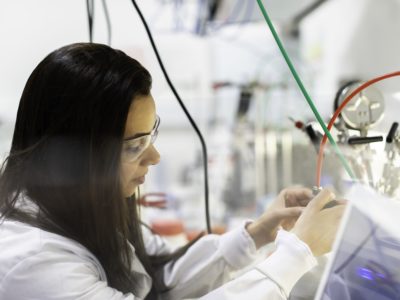Attending a STEM college is already extremely challenging, but going to college while choosing a major dominated by men can be even harder. With less than 30% of STEM students being women, it’s important to go to a school that acknowledges this gap and provides the necessary support for its students. The male/female ratio of the school proves important for knowing how much space the girls have at the school, while the graduation rates shows whether or not the university gives enough academic support to students. Additionally, clubs and research dedicated to women in STEM can help students academically and professionally, which in turn will help them find a job after school.
Keep reading to see the top 10 colleges for women in STEM.
10.) University of California, Davis

Hello, California! For those who want to dive into research and are willing to take multiple cultural perspectives, UC Davis might be the perfect option for you. The school boasts a 63% graduation rate in four years and an 87% graduation rate in six years. Additionally, 55% of their students are women and 42% of their students land full-time employment within one year of graduation.
UC Davis also commits themselves to giving assistance and necessary resources not only to women, but to all minority groups. The CAMPOS initiative, Center for the Advancement of Multicultural Perspectives on Science, provides mentorship and networking opportunities, an inclusive environment and an incentive for research. Their Association for Women in Science is a club focused on all STEM subjects with a breaching through all disciplines and employment sectors. Anyone who supports women in STEM is welcome to join.
9.) Wellesley College

The women’s college, Wellesley, is full of great opportunities. All of their attention centers around their female students, with 88.7% of their students graduating in six years. At Wellesley, an amazing 96% of their students are employed, accepted to graduate school, participate in a volunteer program or serve in the military six months after graduation.
The school offers many clubs for those interested in STEM fields. For those interested in engineering, the Wellesley Engineering Society—with its 90 members—provides the technical skills and professional development necessary for the career. On top of that, the neuroscience club provides advice for those interested in research.
“For me, getting involved with our business and investment organizations proved to be a crucial step in my career journey. They not only helped me learn about roles that I never heard of before, but also connected me with the resources and people who could guide me in securing those roles myself,” said junior economics and computer science major Mehar Bathia. “Being able to take [additional] courses at MIT Sloan and doing research there have really played a vital role in me being able to develop the necessary technical skills for a career in STEM.”
Research is something in abundance at Wellesley. BioChem Boot Camp, aimed at first-year students, for example, provides an immersive experience for those interested in obtaining laboratory skills. The Paulson Water Challenge engages biology, environmental studies, geosciences, physics and other subjects in research regarding environmental issues. If you’re aspiring to be the next Greta Thunberg, this might be the place for you.
8.) Rice University

For STEM lovers in the engineering and biology fields, Rice knows what you need. Only 48% percent of their students are women, but Rice still supports their female STEM students marvelously. For example, 94.2% of their students graduate in six years and 92% find employment within two years of graduation.
Rice even boasts a group specifically for women in STEM. The Society of Women in Engineering provides students with mentors and friends to help with academic and personal stress. and works within the community to inspire younger girls to grow their interest in STEM. Rice also hosts panels and speaking events throughout the semester for students to hear from women with outstanding experience in engineering and leadership.
“I went to a panel last year with three accomplished women in different engineering fields where students could ask questions, and I learned a lot about what it’s like after you graduate and throughout one’s career,” said sophomore engineering major Anna Frey.
You can really feel the female power at Rice! For those interested in biology, the Institute of Bioscience and Bioengineering hosts a Girls STEM Initiative which immerses economically disadvantaged rising high school sophomore women in biomedical research.
7.) Pennsylvania State University, University Park

Interested in a big school with a strong STEM alumni network? Penn State is your place. Penn State has an 88% graduation rate for females and 46% of its students are women. After graduation, 69.18% of students find employment. Let’s hear it for the girls!
Penn State is especially renowned for women in computer science. The Association of Women in Computing provides mentorship for underclassmen, tutoring sessions “from women, by women,” networking and tech workshops. The association also provides support for Girls Who Code, incentivizing girls from 6th-12th grade to explore coding.
“Penn State provides many programs like career fairs, women in engineering conferences, alumni meetings and mentor-mentee leadership positions that help in understanding the real world more,” said sophomore computer science major Jahnvi Misha.
For those who just arriving on campus, the Women in STEM and Engineering Research Internship provides first-year students a two-semester faculty-mentored internship in a research laboratory at Penn State, perfect for those just starting in the field.
6.) Cornell University

For all biology and environment enthusiasts, you might find your niche at Cornell. The famous Ivy League has a high graduation rate with 93.6% of their students graduating in six years. More than half of students are women, composing 52% of their students and 92% of students are employed after graduation. Girl, Cornell is perfect for you to get that bag!
The Empowering Women in Science & Engineering is a symposium at Cornell as well as a professional development opportunity. EWISE allows students to learn and discuss challenges facing women in science and engineering. For students interested in biology and environmental science, the Cornell Raptor Program provides students the opportunity to become involved with the conservation of birds of prey.
“The Cornell Raptor Program further instilled in me my love for animals and gave me hands on experiences I couldn’t even imagine having, such as trimming the talons of a bald eagle,” said junior biology and information science major Jessica Lecorchick.
The Cornell Institute for Women in Science provides women with experimental and applied research opportunities and demographic studies in areas such as wellness and well-being, and human development, making this the perfect opportunity for students to put their ideas into practice.
5.) University of Michigan—Ann Arbor

If you love the cold and a close community, you might want to consider the University of Michigan. The school cares about the students’ academic success, boasting a graduation rate of 91.6% after six years. Michigan also holds an amazing 50/50 male-female ratio and a 73% employment rate after graduation.
You can make a big school feel small at the University of Michigan through their Women in Science and Engineering Residence Program. Here you’ll find a living-learning community that seeks to support women in STEM. The residence program puts first and second-year students together and features mentors, challenges and opportunities, as well as an alumni weekend. Every Tuesday night there, check out their lists of different activities designed to keep residents engaged.
“I think one of the biggest things that the school offers that people don’t normally think about is the group of students that you’re constantly surrounded by. I have learned so much from my peers about leadership and working in a team, that I would argue it’s one of the university’s greatest resources,” said sophomore Isabel Rolfe.
Their Women in Science and Engineering Program also offers students the resources needed to achieve their desired career. The program includes discussions and readings, and focuses specifically on minority women such as women of color, LGBT women and women who are first-generation in higher education. Four female faculty member of WISE were awarded the prestigious Presidential Early Career Awards for Scientists and Engineers, which highlights women and their independent research.
4.) Mount Holyoke College

Mount Holyoke College, the oldest of the Seven Sister Schools, came into being to provide women with an education to the similar men-only Ivy Leagues. MHC is also a women’s college, with 86% of their students graduating in six years. After graduation, their alumni have amazing outcomes with 66% employed, 21% going on to graduate programs and the rest landing internships, doing volunteer work or starting a business, leaving less than 1% of their alumni unemployed.
During school, MHC students have the opportunity to work in well-equipped science labs side-by-side with faculty. The school also treasures independent research.
“I enjoy participating in independent studies in my professor’s lab. The professor that I worked with did everything possible to give us [a] very fruitful experience and made sure we got the most out of it,” said junior neuroscience major Saee Chitale . “I think having that sense of community in a laboratory group setting is a fun activity, you learn a lot and form great connections with the people you work with.”
Women in any STEM field can join Scientista, a foundation that aims to increase the retention rate of women in STEM by providing training and support for undergraduate women on campusThey hold campus activities such as thematic biweekly learning panels, weekly socials, networking opportunities, monthly STEM presentations and STEM big sister/little sister pairings. For those interested in health careers, the Pre-Health association helps pre-professional students with information about health careers, resources for improving academics and support in continuing education in conjunction with the Office of Pre-Health Programs.
3.) University of Chicago

Living in a big city and studying groundbreaking academics? Sign me up! At the University of Chicago, about 92.9% of students finish school in six years. 49% of UChicago’s students are female and they hold an excellent employment rate, as 92% of their alumni find employment after two years of graduation.
The Chicago Women in STEM initiative also focuses on non-academic opportunities. The initiative helps with finding new ways to approach non-academic careers and hosts the Chicago Women in STEM Symposium, as well as provides mentorship for students. The symposium talks about research and networking opportunities and introduces women to role models in STEM. Fellowships like the Jeff Metcalf fellowship can fund students interested in summer research.
“There’s research for everything: from the vaccine to COVID, medicine to COVID, smart and sustainable batteries, to quantum computing,” said senior molecular engineering major Isadora Kucera. “At the Society for Molecular Engineering we study the intersection of physics, chemistry and biology at the molecular level to solve big problems in science, medicine, technology, etc.”
The University of Chicago hosts the first department for molecular engineering in the United States! The Society for Molecular engineering generates events and support for students and enthusiasts.
2.) University of Arizona

The University of Arizona is the perfect place if you’re looking to be the next Marie Curie. About 53% of its students are women which helps to make the school balanced. 54% of students graduate in four years, and 64.9% in six years. If you want the guarantee of a job after graduation, this university also has an employment rate of 92% after two years of graduation.
The University of Arizona hosts many clubs directed to specific interests. The Women in Physics club, for example, holds weekly meetings, brings inspirational speakers who can talk about the different facets of being a physicist and hosts discussion lunches. The college of engineering also has a mentorship program specifically for women in STEM and professional development programs that connect students with mentors in their desired career field, that students can choose to participate.
“I am a member of NSSLHA, but we also have Speech Hearing Cats of Color (SHCC) which provides a special community for individuals underrepresented in the field,” said junior speech, language and hearing sciences major Cheryl Bear. “My favorite activity that I am a part of is a research lab called L4. I feel like I am gaining skills that I can use in my future career, and it is really interesting to help gather new findings.”
If you would like general help and more guidance on what path to follow, the Women in STEM Council has your back. The council provides a “meet and eat” with women in STEM and has many funding opportunities, such as program grants and travel grants. On the University of Arizona’s Women in Science & Engineering website, you can also find many funding opportunities for research, like the Weaver Award for Undergraduate Research in Physics for example, making this the perfect school if you have a project you want to put into action.
1.) Stanford University

If you want to be represented, Stanford is your place. Stanford is committed to providing STEM education to all women, creating an inclusive atmosphere through many clubs that focus not only on women, but also provide opportunities to underrepresented students. Stanford claims the highest employment rate of all schools, with 94% of students finding employment after just two years of graduation. The school also boasts a high graduation rate, with 94.3% of its students graduating within six years. Stanford even keeps a balanced record: 50% of its students are women.
Stanford supports women in STEM by hosting an annual Women in STEM symposium and providing a mentoring program. The Women in STEM Mentoring Pilot Program is designed to help undergraduate students with their life after college by providing guidance and networking opportunities. The program creates a support system to underrepresented students and connects undergraduate students with graduate students, with the objective of demystifying the graduate school application process.
The school also has a plethora of clubs, such as Stanford Women in Computer Science and the Stanford Sisters in STEM. This student organization is designed for students interested in pursuing medicine, with a particular interest in black women. For the Hispanic ladies, Hermanas in STEM meet over lunch for conversations, sharing accomplishments and frustrations and discussing career, academic and personal issues in the context of being Latinx in STEM. The group also brings guest speakers to share their stories for the students. The Women of Color Research Network supports women interested in research mainly in the biomedical field, as well as provides advice and networking opportunities.



















